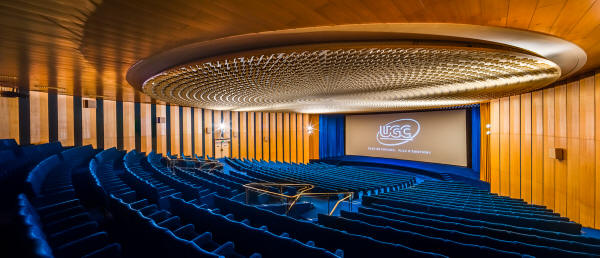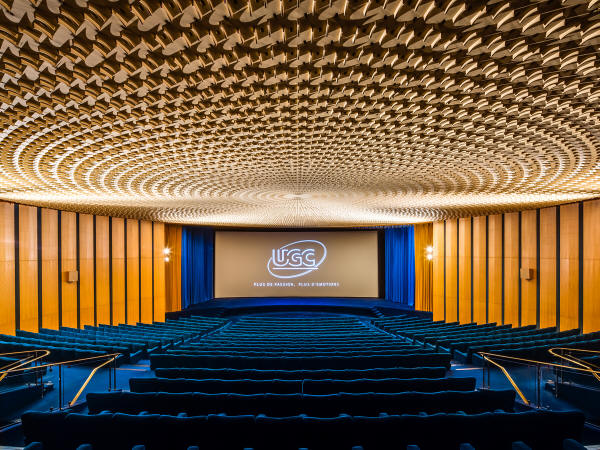UGC Grand Normandie, Paris, France |
Read more at in70mm.com The 70mm Newsletter |
| Written by: Translated from the French page by Google Translate, with some adjustments for clarity | Date: 10.04.2024 |
 UGC
Normandie, Champs Élysées, Paris, France. The capacity is 862 seats and the width of the screen in
Scope is 16,25
meters.
Picture by: Hundven-Clements
Photography. UGC
Normandie, Champs Élysées, Paris, France. The capacity is 862 seats and the width of the screen in
Scope is 16,25
meters.
Picture by: Hundven-Clements
Photography.
It all began in 1935 when the powerful and luxurious ocean liner SS Normandie took to the high seas. The prestigious image it had created very quickly gave rise to the idea of a cinema of similar stature. On February 4, 1937, the Normandie – a 1,940-seat room with a balcony, created inside the premises of a former café also called Normandie – was inaugurated with the world premiere of "Fire over England", produced by Erich Pommer, in the presence of the main actress, Flora Robson. The capacity of the hall was distributed as follows: 1277 seats in the orchestra, 333 seats in the mezzanine and 330 in the balcony. The place, designed by architects Montaut and Gorska, was astonishing with its excesses and its play of lights. The colorful facade extended over two floors. Approaching from front, one would see a mosaic in which the name “Normandie” was inscribed. The hall, vast and long, looked like a private street where the public could be guided by green and red luminescent tubes. The room, expanding, fan-shaped into a space 45 meters long and 37 meters wide and with a height of 14 meters, was a vast volume of harmonious lights. For music hall sketches, the stage was 8 meters deep and the orchestra pit was generously oversized. The walls, stripped of any decoration, were covered in creamy white fabrics enhanced with small luminous portholes, reinforcing the nautical connection to its namesake ship. The most impressive thing remained the voluminous stage frame. Constructed on several planes in expanding repetitions, each time a bit larger than the screen, and delimited by two rounded columns, it stood out as if freestanding in air thanks to indirect lights which could be tinted as desired. • Go to Belguiral's Max Linder Panorama • Go to A Picture Visit to Kinopanorama in Paris, 1990 |
More in 70mm reading: UGC Grand Normandie, Paris, France 70mm Cinema and Film in France "Tenet" in the splendour of 7OMM Belguiral's Max Linder Panorama A Picture Visit to Kinopanorama in Paris, 1990 |
 UGC
Normandie, Champs Élysées; Paris, France. Picture by: Hundven-Clements
Photography UGC
Normandie, Champs Élysées; Paris, France. Picture by: Hundven-Clements
PhotographyAs for the ceiling, it was covered with red and green tubes, forming hairpins; the same ones which had already guided the spectator from the entrance to the room. These lights were the pretext for all the additional effects. Animations were responsible for preparing an "atmosphere" specific to each film. Thus, during airplane battles on the screen, clouds could be projected on the walls to put the viewer in the heart of the battle. All this, in a cozy atmosphere, gave the impression of being on board the magnificent ship whose name the room bears. On its exterior facade, one could read issues of the newspaper, “Normandie – Le Petit Parisien”. Built by the "Actual" company, owner of the newspaper, the Normandie cinema welcomed in its hall information and current affairs dispatches from the “Petit Parisien”. In addition to such newsreel items, the program consisted of a major exclusive film and a major music hall production for the evening presentations. First devoted to American talking films in their original version, the Normandie began offering French films from 1938, Pathé having taken over the programming. The room maintained its activity during the war but, unlike the Marignan or the Rex, did not become a “Soldatenkino”. In 1955 the hall was renovated, at which time it lost its portholes and the orchestra pit. In 1967, the Normandie room celebrated its 40th anniversary with an ultimate do-over. The UGC, then owner of the famous cinema, decided to refresh the place into a new, ultra-modern prestigious room. The old room was completely demolished in the course of these renovations. On September 4, 1969, after two years of work, the new Normandie was inaugurated with "Let the Beast Die", directed by Claude Chabrol. 12 Blue Bell Girls were on the stage before the screening to cut the symbolic ribbon (of film) for everyone to see. Smaller than the old room, since the seating now had fewer than 900 seats, the new room, an ovoid-shaped amphitheater, was entirely designed for optimal acoustics and with visual comfort in mind. This is the same room that one can still visit today. |
|
 UGC
Normandie, Champs Élysées; Paris, France. Picture by: Hundven-Clements
Photography UGC
Normandie, Champs Élysées; Paris, France. Picture by: Hundven-Clements
PhotographyThis room, quite unique at the time, was joined by an entrance hall covered in mirrors, a confectionery stand, a cafeteria, telephone booths, white marble toilets, as well as a daycare center for children, complete with hostess-nurses. The new Normandie returned to prestigious premieres. In 1974, for “That’s Entertainment!”, a canopy at the entrance and a garden with flower beds in the lobby were installed. Spotlights swept the sky while the flashes of the cameras crackled at the entrance. That’s Entertainment! But, as the years progressed, time and changing patters of distribution forced some new thinking of the operations. The Normandie needed to find additional screens to make its large hall profitable. An adjoining dance hall “Le Relais de Chaillot” was bought and became a second screen, decorated with cut stones. Around 1978, in the immense space of the former Normandie orchestra pit, left vacant for all these years (ten years!), the new Lido cabaret was set up. To do this, the Normandie hall was reduced by half, and the checkout was moved forward. Subsequently, another screen was built in unused areas, and a final (4th) one being set up in the basement of the adjoining building, built in place of the former Cinéma des Champs-Elysées, formerly a superb room with a glass roof and marble walls. The cinema today has these four screens with 862, 274, 246 and 151 seats. The largest screen, recently renamed “Grand Normandie”, has a screen 16.5 meters wide in scope and was one of the very first rooms in France to be equipped with digital sound in 1992 (LC Concept process). It was renovated to look exactly the same very recently. Now it has very comfortable armchairs in a very particular Ming blue, which do not exist anywhere else. It remains THE hall for prestigious previews and THE prestigious Parisian hall for cinema. It is one of the largest rooms in Paris (after Le Grand Rex, 2750 seats, and the largest cinema on the Champs-Elysées). It has recently inaugurated new LED exterior signage in August 2020. From Monday August 24, 2020, Grand Normandie will present "Tenet" exclusively in Paris in 70mm. With the exception of a single screening of "Dunkirk" in 70mm as part of the Studio Show convention for cinema operators, the last film commercially released in 70mm in this cinema was “Who Framed Roger Rabbit” in October 1988! |
|
| Go: back - top - back issues - news index Updated 22-01-25 |
